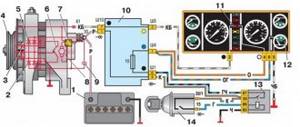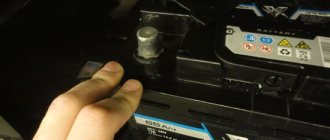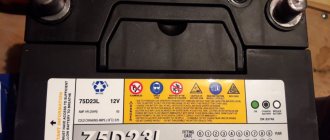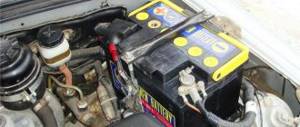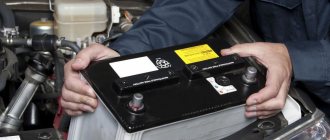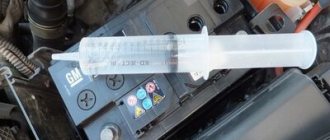Checking the battery charge level takes little time and does not require high qualifications or expensive equipment. The operation allows you to check the condition of the battery and the need for charging. This is the first thing to do if you have problems with the starter. Also, the ability to check the charge will be useful when buying a new battery or servicing an old battery. In this article we will look at three ways to diagnose a battery: using a multimeter, an indicator and a load plug.
In this article you will learn:
- Why check the battery charge?
- Ways to check the car battery for performance
- Video instruction
Also at the end of the article you can watch an instructive video that gives useful tips for quickly and accurately checking the performance of the battery.
Why check the car battery charge?
Lead-acid batteries, which are used in cars with internal combustion engines, have low internal resistance. This allows them to deliver the hundreds of amperes of current required to operate the starter. However, this type of battery cannot be subjected to deep discharge. Otherwise, the plates become covered with a layer of lead sulfate and the battery suddenly loses capacity.
A fully charged battery produces a voltage above 12.6 V. As the charge level drops, this figure decreases:
- 50% - 12 V;
- 0% - 11.6 V.
Given the tendency to sulfate, it is undesirable to discharge lead-acid batteries to less than half the charge. Therefore, if the voltage at the terminals drops to 12 volts, you need to immediately charge the battery.
How to properly prepare a battery for winter? Raising the density of the electrolyte
When purchasing a new device, you should not buy severely discharged batteries. It is possible that sulfation of the plates has already begun in them. Therefore, if there is no indicator on the battery, it is worth checking it with a multimeter or a load plug.
The jar has shorted - why is it scary?
As you understand, the battery needs to be used, charged, maintained, etc. correctly. For example, if there is an overcharge, then the lead plates in the structure can simply crumble, in the literal sense of the word, to the bottom of the jar, which will reduce the accumulation of battery energy to a critically minimal level.
But it happens that a piece of lead falls out of the plate, which bridges the plus and minus plates. This results in a short circuit.
Read also: Do-it-yourself grill made from a wheel rim photo
It may also be due to lead sediment falling to the bottom, the whole point is that the plates reach the bottom, and if the sediment fills the lower part, then it is the cause of the short circuit.
The battery cannot charge to the required 12 - 13 Volts, and the voltage flounders around 10 - 11V. That is, a closed bank does not work! Such a battery cannot crank the engine starter, and therefore is practically useless in the car; replacement is required.
How to check the battery charge using the indicator?
Many maintenance-free batteries have charge indicators that allow you to visually determine the condition of the battery. This option first appeared on Japanese products and quickly gained popularity due to its convenience and accessibility.
The hydrometer, as the indicator is called, is a transparent window on the battery cover. The color of the window changes depending on the condition of the battery:
- Green —full charge.
- Gray or white - need to be charged.
For some indicators, the window turns red when capacity is lost.
The principle of operation of the device is based on changes in the density of the electrolyte at different charge levels. It works like this:
A tube with a green float is attached to the window.
- When charging the battery, the density of the electrolyte increases and the float rises, approaching the window.
- If the battery is discharged, the density drops and the ball sinks in the electrolyte. As a result, the indicator window changes color to gray or black.
Some indicator models have a red ball that floats up when the density of the electrolyte decreases. This provides a red indication of the discharge.
When the electrolyte level drops, not the ball, but the electrolyte itself will be visible through the window. To prevent the destruction of the plates, you need to add distilled water to the jars and charge the battery.
The advantage of the indicator is that the device allows you to determine the condition of the battery without the use of special instruments. This is convenient when purchasing a battery or in road conditions when you need to quickly check the condition of the battery. However, indication using a float does not always allow one to draw accurate conclusions about the performance of the battery. Therefore, when in doubt, you should use a multimeter or a load fork. They are also useful when you need to check a battery that is not equipped with an indicator.
Do-it-yourself repair - how to restore the battery correctly
Having reached the electrolyte, you need to check three parameters:
- Color. The electrolyte should be transparent, without foreign inclusions. The collapsing lead plates give the liquid a dark color.
- Level. As water evaporates, the electrolyte level drops, which reduces power. Each battery has its own liquid level parameters, but all batteries must have plates immersed in electrolyte.
- Density. It is checked with a special device - a hydrometer. The density of the electrolyte in a charged battery is 1.27.
Important! When working with electrolyte, use personal protective equipment! Wear goggles, protective gloves and a respirator. Electrolyte splashes in the eyes or on the skin will cause a chemical burn.
The procedure for diagnosing a maintenance-free battery is as follows:
- We check the voltage of the battery and the vehicle's on-board network. This is necessary to prevent chronic undercharging of the battery. During short, frequent trips, the battery does not have time to charge; as the temperature drops, the capacity drops by 20 - 40%. Many owners blame working equipment, although it needs to be operated correctly.
- We charge the battery. For charging, it is advisable to use a factory-made charger, preferably with a controller. The use of electronics will increase the accuracy of the charge. If the charger is idle, set the current to approximately 0.1 of the capacity. A 60 A/h battery needs to be charged with a current of 5 - 6 Amps. Charging continues. until the ammeter readings drop to 2-3 amperes. A severely discharged battery needs to be charged with a current of 1-2 amperes (about 1/20 capacity) for several days. The voltage should not exceed 15 volts, otherwise the jars will “boil” and may swell.
- Drill holes in the battery cover. We check the electrolyte level using an improvised dipstick. If the battery case is made of light plastic, then the level can be checked by shining a flashlight through the battery.
- We check the density with a hydrometer.
- After checking and topping up, the battery must be tightly closed.
This is interesting: How to completely discharge a screwdriver battery
How to correct electrolyte status
There are three options for correcting electrolyte density:
- At a normal level, low density. We use a hydrometer to take out the entire contents of the jar and pour it into a glass container. Add concentrated acid and bring the density to the recommended level. Fill the electrolyte into the jar to the level.
- When the electrolyte level is low, the density is high. You need to add distilled water, stirring the electrolyte with a glass rod. After work we measure the density.
- At normal levels, high density. Drain the electrolyte, add distilled water, fill to the level.
Important! The density of the electrolyte is its main characteristic. The entire operation of the battery depends on maintaining this parameter normally.
When performing battery maintenance, you can drain all the electrolyte into a glass or enamel container, stir and check the density. Pour the normal electrolyte back into the jars, and if there is a shortage, add fresh electrolyte with the appropriate density. Topping up should be done evenly into all jars so that the amount of fresh sulfuric acid is the same in all jars.
Operation after maintenance
Once opened, a maintenance-free battery loses its sealed properties. It is better not to use this type if the structure is turned over or is standing in the car.
Any interference with the labyrinth lid will lead to loss of the properties of capturing and condensing distilled water vapor. The repair turns a maintenance-free battery into a serviceable one. You will have to look into the battery more often.
Complete battery maintenance by charging. It is discharged by connecting several energy consumers, and then charged. small currents. After two or three charging cycles, it is advisable to check the battery with a load plug. If the battery capacity has dropped sharply, you should decide to replace it.
How to check battery charge with a multimeter?
To check the voltage at the battery terminals you need a voltmeter. However, instead of these specialized devices, it is easier to use universal measuring devices - multimeters. In addition to voltage, they measure current and resistance. Depending on the indication method, these devices are divided into two categories - digital and pointer . If you have a choice, it is better to buy a digital multimeter. It is simpler and more convenient to use.
On-board computers of modern cars are also equipped with voltmeters that display the voltage at the battery terminals. However, they are not connected directly to the terminals. Therefore, due to contact and wiring resistance, the on-board computer readings may differ from the battery voltage. With the engine running, the voltmeter on the dashboard shows too much voltage. If the engine is turned off, the device will give low readings.
Readings must be taken with the engine running and switched off. In the first case, you will be able to check the condition of the battery and wiring, in the second - only the battery.
Measurements while the engine is running
Place the car on a level surface, open the hood, put the handbrake on and start it. When the engine is running, the generator and voltage regulator operate, which charge the battery. Therefore, the voltage at the terminals should be within 13.5-14 volts. In some cars, when the battery is discharged and the air temperature is low, the electronics automatically increases the voltage to speed up charging. In this case, it should fall smoothly as it charges. If this does not happen, the electrolysis process is activated in the banks. The electrolyte will begin to boil away rapidly. Overcharging is especially dangerous for modern gel batteries with limited gas emissions.
A voltage of less than 13.4 volts is a sign of undercharging. Operating in such conditions promotes sulfation of the plates and shortens battery life.
When measuring voltage, you need to turn off all powerful consumers: headlights, heater, audio system. Otherwise, the power of the generator when idling will not be enough to maintain the optimal voltage level.
There are several possible reasons for low voltage at the terminals:
- Poor contact.
- Generator failure.
- Voltage regulator malfunction.
You cannot operate a machine whose battery is in undercharge mode. The cause of the failure must be immediately localized and eliminated. If the voltage at the terminals and the output of the generator is very different, you need to clean the contacts on the battery with sandpaper or a file.
After checking without load, you need to turn on the headlights and other powerful energy consumers, add engine speed and repeat the measurements. If at high speeds under load the voltage drops to 13.4 volts or lower, diagnostics of the generator system and control unit is required.
Diagnostics of the battery with a multimeter with the engine turned off
In this state, the normal voltage on the battery is 12.5-13 volts. Lower readings on the device indicate a discharge.
| Voltmeter readings under load | >12.7 V | 12.5 V | 12.3 V | 12.1 V | <11.9 V |
| Charge percentage | 100% | 75% | 50% | 25% | 0% |
Measurements are taken with power consumers turned off after parking for an hour or more. Otherwise, the readings may be overestimated.
It is useful to check and record the readings before and after a long period of parking. This way you will know the rate of self-discharge of the battery.
Using a Multimeter to Test
This device is in demand not only among motorists. It is used in any area related to electrical measurements, including using it to check the performance of the battery. The versatility of such a tool is explained by the fact that it combines a voltmeter, an ohmmeter, and an ammeter. The compact device does not take up much space in the car and is always ready to take the necessary measurements. The battery reserve lasts for a long time, if you remember to turn it off during a break in work.
When choosing an assistant to repair car electrical wiring at home, you need to take into account the following characteristics:
- DC voltage is measured in the range from 0 to 200 mV, 2 V, 20 V, 200 V, 1 thousand V, and alternating voltage is measured from 0 to 200 V, 750 V.
- Resistance testing parameters range from 0 to 200 ohms.
- The DC current run-up in most models is 2, 20, 200 mA.
We recommend: Cleaning the battery with a desulfator according to scheme 555
These basic parameters can be supplemented with different values and functions depending on the device model.
Battery voltage measurement
This is the most important parameter of the battery’s suitability for operation.
Many drivers test this indicator first. This is done with the engine running. If the device scale displays values from 13.5 to 14 V, then everything is in order with this characteristic. Increased numbers will indicate a low charge level and more energy being supplied from the generator to maintain operating mode. This case often occurs in winter, when a faulty battery runs out of power. There is no need to worry about short-term exceeding the standard data. In a technically sound car, the level stabilizes within 10 minutes. If during the specified period the indicators have not been restored, you need to pay attention to the serviceability of the voltage regulator or the condition of its contacts. If they become oxidized, they need to be cleaned. If there is a decrease in potential below 13 volts, you should think about replacing the battery, as this is an indicator of a faulty element.
If you take measurements with the car not running, you should pay attention to the following nuances:
- A voltage lower than 12 volts will not allow the engine to start, especially in cold weather with thickened oil. The crankshaft will not turn due to insufficient force in such a situation. A normal level is considered to be no weaker than 13 V.
- All measurements should be taken before the start of the movement, and not immediately after its completion.
- A larger charge will keep the battery operating for a longer period. At a lower level, it will sit down faster. Therefore, a new battery or one in close to this condition remains operational longer.
Battery charge and capacity
To check a car battery using this method, you need to analyze the data from a multimeter. Measurements should be taken 5 hours after recharging or disconnecting the battery from the machine. The data in this case will be more accurate. They do not depend on the ambient temperature.
Considering such measurements, the following patterns should be noted:
- A potential difference of 12.8 V indicates a fully charged battery. A large excess hints at serious malfunctions.
- The 75% balance is indicated by the figure 12.6 V.
- The marking 12.2 is taken as half.
- 12 volts will indicate a quarter of the resource.
- Anything less than the last value indicates a minimum reserve.
Information about capacity is no less important than charge. You can test it in the following way:
- The battery must be fully ready for use.
- Apply load to the battery. You can connect several lighting fixtures in series.
- A weak glow at a voltage of 12.4 volts guarantees problems with starting the engine in winter.
- Reducing the data below 12 V requires replacing the battery.
Such a check of the car battery provides an opportunity to avoid problems during start and movement, as well as prolong the operation of the product.
In addition, you can test the capacity by checking the control charge:
- The battery must be completely full.
- Turn it on at deep load according to the passport.
- Connect the device to the circuit.
- Measure the time it takes for the current to decrease by half.
- If it matches what the manufacturer stated, then the battery is working.
We recommend: Titanium battery for a car and a car battery device
Leakage current measurement
For any car, even a completely new one, this is an inevitable phenomenon. This is explained by the minimal electricity consumption of some consumers even when the engine is turned off. In reference books you can find numbers from 10 to 80 mA depending on the device. If this data is greater, then we can talk about a malfunction of the machine. The ideal value is 60 mA. The lack of daily recharging due to interruptions in operation has a more negative impact on the condition of the equipment.
Before you begin obtaining information, you need to prepare the vehicle for testing:
- Disconnect the interior lighting, radio and other consumers.
- Remove the keys from the ignition.
- Check the information received. Exceeding values of more than 60 mA gives rise to a search for the circuit that receives the maximum power consumption. This can be done by elimination, removing fuse blocks one by one.
This preliminary procedure will provide more accurate information about both the condition of the battery and the power supply circuits.
The procedure for checking leaks is as follows:
- Set the measuring range to 10 A or 20 A.
- Disconnect the minus battery.
- Connect the probe of the device to this place.
- Connect the second one to the removed wire.
- The result will be shown by an indicator board or arrow.
How to test a battery with a load fork?
This is the most accurate method to determine the state of charge and the ability of the battery to operate at full load. It is used by professional auto electricians in service centers.
A load fork is a device that combines a voltmeter and a load resistance. Advanced versions of the device are also equipped with an ammeter, which allows you to estimate the load current. The fork operates in two modes:
- battery voltage measurement;
- imitation of starter operation.
Before starting the test, you should turn on the voltmeter mode on the load plug and connect it to the battery. If the device shows less than 12.7 volts, the battery needs to be charged.
| Voltmeter readings under load | >10.2 V | 9.6 V | 9.0 V | 8.4 V | <7.8 V |
| Charge percentage | 100% | 75% | 50% | 25% | 0% |
You can only check a fully charged battery with a load fork!
In addition to the voltage, it is necessary to check the electrolyte in the battery being serviced. It should have a level 10-15 mm below the filler hole and a density of 1.27 g/cm3 at 25 degrees Celsius. In northern regions, the electrolyte density can be increased to 1.29 g/cm3.
To check, a special device is used - a hydrometer . This is a glass container with a float inside. The float has a scale on it that can be used to determine the density of the liquid in which it is immersed.
Before measuring the density of the electrolyte, it is necessary to check the level and, if necessary, add distilled water to the jars. After topping up, the battery needs to be charged.
Diagnostics is performed as follows:
- connect the load plug;
- turn on the load resistance for 5 seconds;
- switch the plug to voltmeter mode.
The voltage at the battery contacts in the fifth second of operation of the load resistance indicates the level of battery performance.
Frequent use of the load fork accelerates battery wear. Therefore, when checking regularly, it is better to use a multimeter or indicator.
Checking the battery with a load device (discharge device)
As a rule, such a test is used only for service (warranty) purposes and serves to measure the residual capacity of the battery. According to its purpose, a car battery is a starter battery, i.e. its task is to produce the maximum current in the shortest time - SSA (A). We will measure this parameter with a starting current tester. The second important parameter is the battery reserve capacity. Those. This is the battery capacity in minutes assuming generator failure. This capacity reflects the approximate operating time of the vehicle with faulty equipment. And the last indicator is the electrical capacity in A*h. For example 60-70 Ah.
The last 2 parameters can be measured with a stabilized current load device. The battery loader discharges the battery. Knowing the discharge time and current strength, the capacity in A*h or reserve capacity in minutes is measured. Such testing completely removes the uncertainty of the battery condition. If the battery has a small capacity, then the cold cranking current will be very low.
Why can't you measure capacitance with a light bulb? The answer is simple - as the battery discharges, both the voltage and current passing through the light bulb will decrease - the light bulb will shine weaker and weaker. Such a discharge does not provide any useful information about the battery capacity - it is simply a waste of time.
The battery testing methods described above are valid not only for testing car batteries, but also batteries in uninterruptible power supplies, traction batteries in forklifts and other applications. For each such application there is specialized equipment.
Decisions on publication topic
RBA15
Electronic load fork Ring RBA15
12V, load current 125A, digital screen5 690 ₽
RBA50
Ring RBA50 Battery Tester
Battery tester 12V up to 1700SCA8 300 ₽
MDX-545P
MDX-545P Midtronics Battery Tester
Battery tester 6/12 and charging system 12V, up to 1200CCA83 712 ₽
BSL-12/20
Battery discharge device 12V 20A “CONBAT”, BSL-12/20 (State Register)
Battery capacity tester voltage 0-20V, current 0-20A31 663 ₽
How to check with a charger?
A car charger equipped with a digital or analog voltmeter is designed for charging and diagnosing a battery.
To do this, you need to unplug the device from the outlet and connect it to the battery. The degree of charge of the battery is determined based on the voltage at its terminals .
Chargers with a digital scale do not need to be unplugged. They have a special button for checking the charge level. All you have to do is press it and read the device readings.
Conclusion
To regularly approximate the battery charge level, just look through the indicator window at its covers. If the device is not equipped with an indicator or you want to learn more about the condition of the battery, you should use a multimeter. It will help assess the performance of the car's battery, wiring and alternator.
The load plug should only be used occasionally, when you need to make sure that the battery is capable of delivering enough current to operate the starter. In other cases, it is enough to check the density and measure the voltage at the battery terminals.

